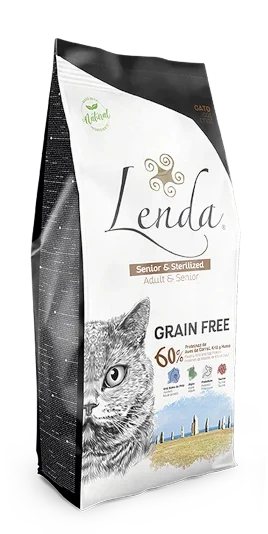Senior & Sterilized
Product Summary
Lenda Senior & Sterilized dry cat food is designed specifically for older and sterilized cats. It supports weight management and promotes healthy aging through a high-protein formula. This grain-free product contains 34% crude protein, primarily sourced from poultry and krill, and includes functional supplements like glucosamine and chondroitin for joint support. The food is free from artificial preservatives and colorings, wheat, and red meat, making it a natural choice for cats with sensitivities. The formula also includes probiotics to aid digestion and overall gut health.
Pros:
- High Protein Content (34%): This food offers a strong protein foundation, primarily from animal sources such as poultry and krill, which is essential for maintaining muscle mass in senior cats.
- Grain-Free Formula: This formula excludes grains to reduce the risk of digestive issues, making it suitable for cats with grain sensitivities.
- Joint Support: The inclusion of glucosamine and chondroitin helps maintain healthy joints, a critical feature for senior cats prone to arthritis or joint discomfort.
- Digestive Health: Probiotics are incorporated to support gut health and improve digestion, especially in aging cats.
- Natural Composition: The food is free from artificial preservatives and colorings, relying on natural ingredients that minimize the risk of allergic reactions.
Cons:
- Moderate Fat Content (12%): While the fat level is moderate, it could be too high for some sterilized cats prone to weight gain if portions are not carefully controlled.
- High Carbohydrate Content (35.6%): Despite being grain-free, the carbohydrate content remains relatively high, which may not be ideal for obligate carnivores like cats.
- Limited Nutrient Breakdown: While the food is rich in beneficial supplements, the detailed breakdown of fiber and other nutrients could be more comprehensive.
Ingredients
Vitamins and Additives
Notes
The score is calculated after relocation of fresh meat or fish ingredient(s) as explained in the calculation rule #7 in Chapter 1.
Guaranteed Analysis
Notes
The score is calculated after relocation of fresh meat or fish ingredient(s) as explained in the calculation rule #7 in Chapter 1.





